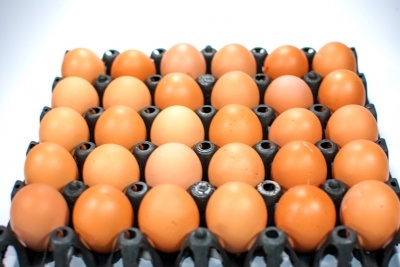
Eggs are a basic food throughout human civilization and a provider of much needed nutrition. They also have exceptional functional benefits throughout food manufacture such as in cakes making, various desserts, a scotch egg, in a carbonara sauce for pasta, etc.
We can also use two parts of an egg. The egg yolk is a good base for a sauce such as a carbonara and the egg white is used for meringue or for stiffening batters. They really are truly versatile. The egg shell usually goes into the compost heap where it adds back calcium into the soil – no one loses with an egg.
The egg yolk also yields exceptionally good emulsifiers.
What Is An Egg Made Of?
To understand functionality means we start with the composition of an egg.
They consist of three distinct fractions (Cotterill & Geiger, 1977).
- egg white (about 63-65%)
- egg yolk (about 27.5%),
- a shell with its membranes (9.5%).
The basic composition of eggs has been established as above for many years. Changes in production methods have produced relatively minor changes in its nutritional composition. It still retains some fundamental values which are unlikely to ever alter.
A more up to date examination has produced ranges for each fraction (Cherian et al., 2002) so that we now have different styles of eggs even.
- egg white (about 56-64%)
- egg yolk (about 25-33%),
- a shell with its membranes (9-11%)
The whole egg contains about 75% water, 12-13% protein, 9.5-11% lipid, and 1% carbohydrate (Deleu et al., 2015).
Virtually all the fat is found in the egg yolk in the form of lipoproteins. The proteins though are fairly evenly distributed. About 50% is egg white albumen and in the egg white, 44% of protein is in egg yolk and the eggshell with any membrane contains 6% (Sugino et al., 1997).
Composition Of Egg White
Egg white mainly consists of water (about 76% by weight), proteins (about 11 %), and a minimal level of carbohydrates (0.72%) plus some vitamins and minerals (Bennion & Bamford, 1997; USDA, 2020).
The protein component comprises many different proteins, including ovalbumin [OVA] (54%), ovotransferrin (12%), ovomucoid (11%), ovoglobulin (8%), ovomucin (3.5%), and lysozyme (3.4%) (Mine, 1995).
Composition Of Egg Yolk
Egg yolk contains water (about 50%), lipids (about 34%), and proteins (about 16%).
The lipids are mainly triacylglycerols (66%), phospholipids (28%), and cholesterol (5%).
The major egg yolk proteins are livetin (30%), phosvitin (11%), and lipoproteins, which are low‐density lipoprotein (LDL) (23%) and high‐density lipoprotein (35%) (Anton, 2007).
Quality Indices Of Eggs
One of the most important measures of egg quality is HU which is related to age-related changes in egg white proteins (Pan et al., 2011).
Regulatory Definition Of An Egg
It may seem peculiar to explain why an egg is defined in terms of its integrity but there are specific ingredients where the exact nature of the egg is important.
Bioengineered foods for example in the USA have the egg exempted from the BE standard because egg production is exempt owing to the application of the EPIA.
According to the European Union, an egg refers to the yolk and its sac within a shell. Otherwise, it is a broken, cooked or incubated egg. These are produced by hens of the genus Gallus and must be fit for direct human consumption or for the preparation of egg products. It cannot be more straightforward than that (EU, 2008).
Egg protein is generally of very high quality so they are regularly used as a measure of quality for other food proteins (Seuss-Baum, 2007)
References
(2007). Composition and structure of hen egg yolk. In R. Huopalahti, R. López‐Fandiño, M. Anton, & R. Schade (Eds.), Bioactive egg compounds (pp. 1–6). Berlin, Germany: Springer.
, & (1997). The Technology of Cake Making. London, UK: Blackie Academic and Professional.
, , & (2002). Fatty acid composition and egg components of specialty eggs. Poultry Science, 81(1), pp. 30–33. (Article)
, & (1977). Egg product yield trends from shell Eggs1. Poultry Science, 56(3), pp. 1027–1031. (Article)
Deleu, L. J., Wilderjans, E., Van Haesendonck, I., Courtin, C. M., Brijs, K., & Delcour, J. A. (2015). Storage induced conversion of ovalbumin into S‐ovalbumin in eggs impacts the properties of pound cake and its batter. Food Hydrocolloids, 49, pp. 208–215. (Article)
European Union (2008). EUR‐Lex Commission Regulation (EC) No 589/2008 of 23 June 2008 laying down detailed rules for implementing Council Regulation (EC) No 1234/2007 as regards marketing standards for eggs.
(1995). Recent advances in the understanding of egg white protein functionality. Trends in Food Science and Technology, 6(7), pp. 225–232 (Article)
(2007). Nutritional evaluation of egg compounds. In R. Huopalahti, R. Lopez‐Fandino, M. Anton, & R. Schade (Eds.), Bioactive egg compounds (pp. 117–144). Berlin, Germany: Springer‐Verlag.
Sugino, H., Nitoda, T., & Juneja, L. R. (1997). General chemical composition of hen eggs. In: L. J. T. Yamamoto, H. Hatta, & M. Kim. (Eds.), Hen eggs their basic and applied science. New York: CRC Press, Inc.
USDA. (2020). Retrieved from https://fdc.nal.usda.gov/fdc-app.html#/food-details/783909/nutrients


Leave a Reply